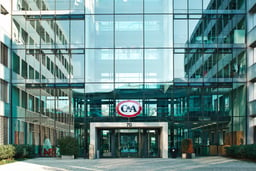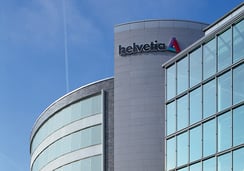Key app modernization tools
In addition to the technologies mentioned, there are specific tools designed to assist with the process of application modernization.
These tools can help organizations manage their application portfolios, understand their current IT landscape, and plan their modernization efforts effectively.
- Enterprise architecture tools: A tool like SAP LeanIX provides a comprehensive view of your enterprise architecture, aiding in strategic IT planning and identifying areas ripe for modernization. Get a deeper dive into selecting an enterprise architecture tool.
- Cloud migration tools: When it's time to transition apps to the cloud, cloud migration tools become invaluable. They simplify the process by offering features for discovery, migration planning, and workload mobility.
- Application portfolio management tools: To effectively prioritize modernization efforts, application portfolio management tools, such as SAP LeanIX are key. They help discern which applications should be modernized, replaced, retired, or maintained.
- Modernization platform tools: The actual task of modernizing apps is facilitated by modernization platform tools. They provide a platform that supports various modernization strategies, including rehosting, re-platforming, rearchitecting, or rebuilding applications.
- Code refactoring tools: In many modernization efforts, refactoring code to improve its structure without changing its behavior is crucial. Code refactoring tools assist developers in this task, enhancing the efficiency and maintainability of the code.
- Container orchestration tools: With the rise of containerization and microservices, container orchestration tools have become indispensable. They handle the deployment, scaling, and load balancing of containers, fostering the development of scalable and resilient modern applications.
- API management tools: APIs act as connective tissue in modern, distributed applications. API management tools ensure these APIs are designed, deployed, secured, and monitored effectively, delivering the required functionality and performance.
Choosing the right tools can significantly impact the success of your application modernization efforts.
The business case and benefits
Application modernization is a strategic investment that yields significant benefits across different levels of an organization. The importance of this process is reflected in industry trends and forecasts.
According to Gartner, 85% of organizations will modernize their applications with a cloud-first approach by 2025.
Furthermore, the 2023 Gartner CIO and Technology Executive Survey results show 46% of organizations will increase their spending on application modernization, and 50% will increase their spending on cloud platforms in 2023.
“Many organizations are dealing with bloated application portfolios with high technical debt, risk and cost. In such a case, a modernization initiative with additional funding is required to “cure” the application portfolio from intolerable risks and obstacles.” [Source: Gartner]
Here's how application modernization impacts development teams, IT, and business leaders:
Benefits for development teams
- Enhanced productivity: Modern apps and tools can streamline the development process, automate repetitive tasks, and reduce the time spent on debugging and maintenance.
- Improved collaboration: Modern development practices, such as DevOps and Agile, promote a culture of collaboration and continuous improvement, fostering better communication and teamwork.
- Skill development: Working with modern technologies and methodologies can help developers broaden their skill sets and stay current with industry trends.
Benefits for IT
- Increased operational efficiency: Modern applications are easier to maintain and update, reducing the time and resources required for these tasks.
- Risk mitigation: Outdated applications can pose security risks and compliance issues. Modernizing these applications can help mitigate these risks and ensure compliance with current regulations.
- Improved infrastructure management: Modern applications, particularly those hosted in the cloud, can simplify infrastructure management and provide better visibility and control over IT resources.
Benefits for business leaders
- Business agility: Modern applications can be updated and scaled independently, allowing for faster deployment of new features and improvements. This helps businesses respond more quickly to market changes.
- Enhanced customer experience: Deliver a better user experience, supporting mobile and web interfaces, offering faster response times, and providing more personalized and interactive experiences.
- Innovation and competitive advantage: Modernizing applications can unlock new capabilities, such as AI, machine learning, and advanced analytics. These can drive innovation and provide a competitive edge.
- Sustainability: Applications, particularly those hosted in the cloud, can be more energy-efficient than their on-premises counterparts, contributing to an organization's sustainability goals.
While the benefits of application modernization are clear, it's important to note that the process requires careful planning and execution.
It's not a one-size-fits-all solution, and what works for one organization may not work for another. Therefore, it's crucial to develop a clear app modernization roadmap that aligns with your business goals and capabilities.
Most common challenges
While the benefits of app modernization are significant, the process is not without its challenges.
Some of the common obstacles that organizations may encounter during their modernization journey are:
- Understanding legacy systems: Legacy systems can be complex and poorly documented. Understanding how they work and how they're interconnected can be a daunting task.
- Skills gap: Modernization often involves new technologies and methodologies that your team may not be familiar with. Bridging this skills gap can require significant time and resources.
- Business disruption: Modernization efforts can disrupt business operations. Minimizing this disruption and managing the change effectively is a major challenge.
- Data migration: Moving data from legacy systems to new applications is a complex task. Ensuring data integrity and avoiding data loss during this process is crucial.
- Security and compliance: Modernization, particularly when it involves moving to the cloud, can introduce new security and compliance considerations. Addressing these effectively is critical.
- Cost management: While modernization can deliver cost savings in the long run, the upfront costs can be substantial. Managing these costs and ensuring a return on investment is a key challenge.
- Choosing the right approach: There are multiple paths to modernization, and choosing the right one for each application can be complex. Making the wrong choice can lead to wasted effort and resources.
Despite these challenges, the potential benefits of application modernization make it a worthwhile endeavor for most organizations.
With careful planning (next section), the right skills and tools, and a clear understanding of your business needs, these challenges can be effectively managed.
A concise guide to modernizing applications
Application modernization is a complex process that requires careful planning and execution. Here's a high-level guide to help you navigate this journey:
Pre-requisite: Application portfolio assessment
Before you can begin modernizing, you need to understand your current application landscape. This involves assessing your existing applications in terms of their business value, technical condition, and other relevant factors.
SAP LeanIX helps you gain a clear view of your application inventory and identify potential targets for modernization.
📚 Related: Application Modernization Assessment
Step 1: Identify goals and scope applications
Start by defining what you hope to achieve through modernization. This could be anything from improving operational efficiency to enabling new business capabilities. Also, determine the scope of your modernization effort. Will you modernize all your applications or just a select few?
LeanIX can help here by providing a comprehensive view of your IT landscape, helping you identify which applications would benefit most from modernization.
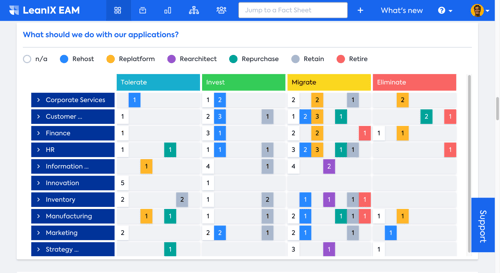
Scope applications in LeanIX EAM
📚 Related: Application Criticality Assessment
Step 2: Plan transformation roadmap
Develop an application modernization roadmap. This should include timelines, resources required, potential risks, and mitigation strategies.
LeanIX can support this step by providing tools for scenario planning and roadmap visualization, helping you create a clear and actionable transformation plan.
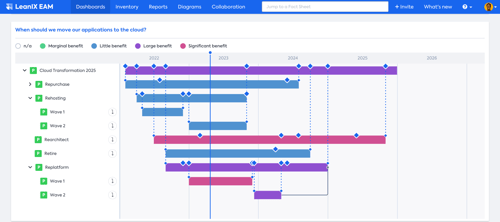
Roadmap with milestones in LeanIX EAM
Step 3: Create transformations
Begin the modernization process according to your plan. This will typically involve developing new applications or modifying existing ones, testing, data migration, and deployment.
LeanIX can assist by providing a collaborative platform where all stakeholders can track progress and coordinate their efforts.
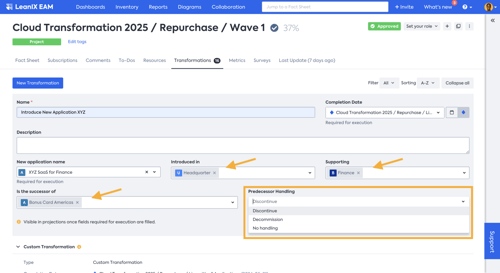
Application modernization template in LeanIX EAM
Step 4: Evaluate your target architecture
Once your modern applications are live, it's important to evaluate whether they meet your original goals and expectations.
LeanIX can help here by providing tools for architecture modeling and analysis, helping you assess whether your new architecture aligns with your business objectives.
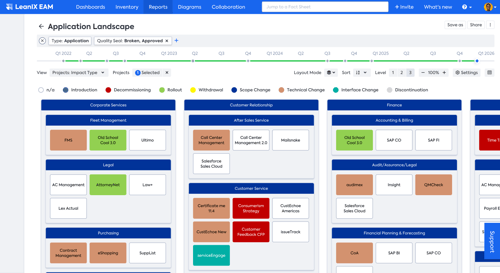
Visualize landscape change in LeanIX EAM
Step 5: Execute, track, and report
The final step is to execute your plan, track the progress of your modernization efforts, and report on the results.
LeanIX can support this step by providing a centralized platform for tracking and reporting and demonstrating the value to stakeholders.
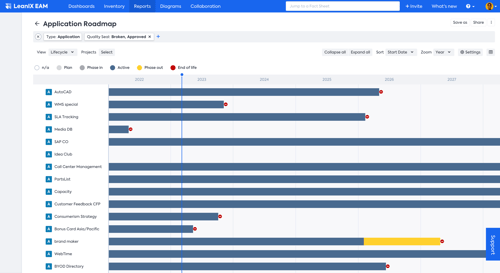
Roadmap Report in LeanIX EAM
📚 Related: Application Modernization with LeanIX


/EN/Reports/Thumbnail-Gartner%20720x500.png?width=260&height=171&name=Thumbnail-Gartner%20720x500.png)










